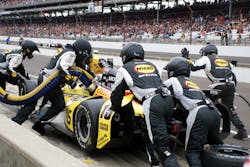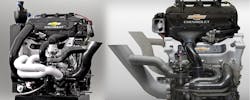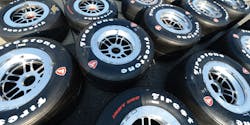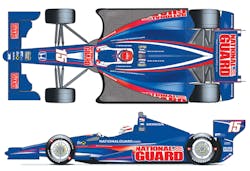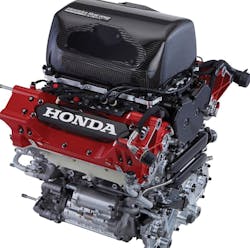This file type includes high resolution graphics and schematics when applicapable.
The 2014 IndyCar racing season is one of transition. Officials are checking on past changes, making some new ones to the chassis and engines, and getting ready for aerokits that could reduce drag and (hopefully) bump up speeds. They are also monitoring their only tire supplier, Firestone (a subsidiary of Bridgestone), to see if the tires will continue to stay ahead of the curve.
The transition is aimed at the 2016 race, the Indy’s 500 100th running. That’s the season in which officials hope at least one racer sets a new speed record for the four-lap qualifying runs. The current record, 236.986 mph, was set by Arie Luyendyck in 1996. Officials and teams see higher speeds as a surefire way to increase interest in IndyCar racing.
Prepping for aerokits
Officials will let teams use aerokits from suppliers other than Dallara this year, but only at the Triple Crown tracks — Indianapolis, Pocono, and Fontana. The rest of the year, race teams will field Dallara DW12 chassis, bodies, and aerokits. IndyCar managers will be watching to see how the kits affect handling and speeds, as well as the conditions of IndyCar racing. The hope is that the kits will counter some of the problems with the relatively new Dallara DW12 chassis. Officials suspect the bottom or undertray of the current chassis is too large and smooth. They base their suspicions on the fact that some Indy racers tend to roll after side impacts on ovals. IndyCar engineers and technicians have already tried solving the problem by reducing the undertray’s surface area, and they hope the aerokits will not cause the problem to reappear or get worse. The goal is to ensure the cars are stable before adding power that could push speeds to new records.
The kits will likely include side pods, engine cover, and front and rear wings. Currently, all teams use the kits that come with the Dallara chassis. But for this year’s Triple Crown tracks, kits will be designed and built by new two teams: Pratt & Miller partnering with GM Racing for cars with Chevy engines; and Wirth Research working with Honda Performance Development for racers with Honda engines. And in 2015, when kits are allowed for all races, Lotus and a few other companies could join Honda and Chevy as suppliers. Dallara will stop making aerokits because it would take too much time and money for the Indianapolis company to build different kits, according to Andrea Toso, the head of R&D for Dallara’s IndyCar project.
Kit manufacturers will likely supply two kits, one with specifications suited to road and street courses, as well as short ovals, and another set with specs for superspeedways.
The kits will cost no more than $75,000 (which will not include the cost for fasteners), and each team has the option to use two of them during the 2015 and following seasons. Upgrades after that are limited in price to $15,000.
As is often the case with IndyCar rules, these regulations could get sidetracked. In 2011, for example, race teams asked for and got a delay in the aerokits introduction when the costs for the new DW12 chassis went over budget. Then in 2012, racers felt they had fast, competitive cars and races and had no need for the kits, or their high costs, so the introduction got put off again.
Timeline for technologiesIndyCar management wants to keep costs down for its racing teams, and using the same chassis for the next decade or more is key to that effort. But they also want to increase speeds, which means introducing aerokits, new tires, and possibly new engines. Here’s their plans for tackling these possible changes in the upcoming years. 2013: Changed smooth underbody to make the car more stable and prepared for aerokits. 2014: Engine upgrades and adjustments to downforce to improve overtaking and safety. 2015: Aerokits and changes to underbody. 2016: Possible changes to tires and increases to engine power. 2017: Possible upgrades to engines and aerokits. 2018: Competition enhancements based on performance of 2017 package. 2019: Review body and chassis for potential upgrades or changes. 2020: Competition enhancements based on performance of 2019 package. 2021: Possible upgrade to aerokits. |
Team owners likely wanted one more delay, but IndyCar’s technical staff has set out a road map for the technical development of the championship, one that includes keeping costs down. Their goal is that new aerokits will improve performance and, thereby, extend the life of the DW12 chassis. This would save teams the cost of buying a new chassis and make their original purchase of the DW12 a more-economical investment. (The current chassis originally sold for $349,000, or as a complete car for $385,000.) IndyCar officials also felt a further delay would upset fans, the ultimate customers for Indy racing.
IndyCar management also hopes the kits will visually differentiate the cars. In an odd note, cars will be named based on the aerokit supplier. For example, if Honda supplies, the kit, it will be a Honda car. If a traditional aerospace firm such as Lockheed makes the kit, a hope of IndyCar officials, the car will be a Lockheed racer.
Equalizing engines
While Honda engines were equipped with only one turbocharger last year, Chevy engines had the advantage of carrying two. That’s one reason some racing enthusiasts say Chevy-powered cars dominated the 2013 season (even though Chevy won only one more race than Honda, and Honda won Indy). To end that “dominance,” IndyCar officials say all cars must carry two Borg-Warner turbochargers. Honda is confident that Chevy’s two extra years of experience with twin turbos will not be a disadvantage.
These engineered for racing (EFR) turbos will let the cars generate 22.5 in. of boost for road courses, 20.3 for ovals, and only 18.9 for superspeedways. Each team is also allowed 10 driver-chosen 15 to 20-sec boosts that increase the pressure to 23.2 psi. Officials are still unsure how much advantage these boosts will give to teams.
Indy officials also say that it was always difficult, if not impossible, to equate the different allowable boost levels when teams have either one or two turbo units. Making all engines carry two of the same turbochargers eliminates the problem.
The 7163 EFR turbos have been upgraded for racing. Weight was cut and the end housings were redesigned for IndyCar engines. But like stock EFR turbos built for performance cars, the turbine wheels and shaft are constructed of strong, lightweight gamma titanium-aluminum alloy for quicker response. And ceramic ball bearings increase the thrust capacity and durability while improving efficiency at low expansion rates. The cast-stainless-steel housing also contributes to efficiency and durability.
Another change, one that pushes teams to focus on engine durability, penalizes teams that change engines before 2,500 miles. Last year, they could change engines after 2,000 miles without incurring a penalty.
IndyCar officials will continue to make certain engine components and configurations mandatory as it proceeds through what they call the homogolation process. Over the next two years, they will specifically look to standardize connecting rods, though the turbos’ wastegates and valve springs, and spark plugs could also be standardized. Items that teams can still change include the cylinder heads and valve angles, port locations and shapes, combustion-chamber shapes, and spark-plug and fuel-injector locations, as well as the ducting for the turbos and camshafts. Some of these parameters have limits teams must respect. The valve angles, for example, can be from 60 to 90°.
Honda provides more than just engines: Safety
Fires in the pit-lane areas and injuries attributed to cars leaving the pit too quickly, even before crews can remove the refueling hose, should be as rare as hen’s teeth at this year’s Indy 500, thanks to the Refueling Safety Interlock. It was developed at Honda Performance Development Inc. (HPD), the subsidiary of Honda that designs IndyCar engines and a host of components for other race series. The interlock includes a fuel-probe sensor and corresponding electronics in the engine-control unit (ECU) and gearbox-control unit (GCU). It prevents first gear from being engaged by the paddle shifter on the steering wheel while the refueling hose is still attached to the car.
The interlock was designed for both IndyCars and endurance sports-car racing, and is now mandatory on Indy racers.
The fuel-probe sensor, installed in the refueling “buckeye” — or inlet valve — on an IndyCar chassis, detects the presence of the refueling nozzle. Software in the ECU signals the GCU to place, or hold, the transmission in neutral. This prevents drivers from leaving the pit before the refueling hose is detached from the car.
While the interlock was being developed, engineers at HPD discovered they would have to modify the sensor to ensure it could survive the harsh operating environment of an IndyCar. For example, they replaced all of the wire leads and resoldered all joints. They also added heat-resistant shrink-wrap to soldered joints, as well as thermal insulation and a motorsports connector to the leads and a fuse to eliminate electrical shorts.
HPD has offered to provide the design of its interlock, free of charge, to other racing series that want it. The only hardware prerequisite is that the cars’ gearbox must have an electronic paddle-shift mechanism.


